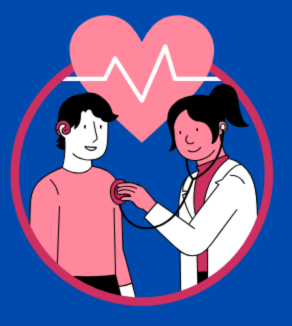Tachycardia is a medical condition when the heart rate is fast and usually higher than the resting heart rate. In this condition heart beat increase more than 100 beats per minute
Tachycardia is frequent and usually not harmful during rare occasions, but chronic or recurrent tachycardia may be a sign of an underlying medical condition that needs to be treated. This post will examine tachycardia’s causes, signs, diagnosis, and available treatments.
Causes of Tachycardia
Tachycardia can occur due to various reasons, including:
- Stress and Anxiety
- Physical Activity
- Fever
- Dehydration
- Caffeine
- Heart Conditions
- Medications
- Electrolyte Imbalance
Stress and Anxiety : Emotional stress or anxiety can trigger the body’s fight response, leading to an increase in heart rate.
Physical Activity : The heart rate naturally rises during physical activity or exertion to fulfil the body’s increased need for oxygenated blood.
Fever : Tachycardia can result from elevated body temperature, such as that experienced during a fever or illness, as the body has to work harder to control its temperature.
Dehydration : Dehydration from inadequate fluid intake can cause tachycardia as the body tries to maintain circulation and blood pressure.
Caffeine : Consuming excessive amounts of caffeine or other stimulants can stimulate the heart and lead to rapid heartbeat.
Heart Conditions : Abnormally fast heartbeats can be caused by a number of cardiac diseases, including supraventricular tachycardia, ventricular tachycardia, and atrial fibrillation.
Medications : Heart rate may rise as a side effect of various drugs, such as decongestants, asthma inhalers, and some antidepressants.
Electrolyte Imbalance : Tachycardia can result from abnormal blood levels of electrolytes like potassium, sodium, or calcium that interfere with the heart’s electrical function.
Symptoms of Tachycardia
The symptoms of tachycardia can vary depending on the underlying cause and individual factors. Common symptoms include:
- Fast heartbeat (typically more than 100 beats per minute at rest)
- Palpitations (sensation of a racing or fluttering heart)
- Shortness of breath
- Dizziness or lightheadedness
- Chest pain or discomfort
- Fainting or near-fainting episodes
- Fatigue or weakness
It’s important to remember that some people could not experience any symptoms at all, particularly in the short term when tachycardia is occurring.
Types of Tachycardia
Tachycardia can be broadly classified into several types based on its origin and the part of the heart involved in the abnormal rhythm:
- Atrial Tachycardia
- Ventricular Tachycardia
- Supraventricular Tachycardia (SVT)
- Sinus Tachycardia
Atrial Tachycardia
This type of tachycardia originates in the upper chambers of the heart (atria) and is often associated with abnormal electrical signals in the atria. Atrial tachycardia may result from conditions such as atrial fibrillation, atrial flutter, or atrial fibrillation.
Ventricular Tachycardia
Rapid and irregular electrical signals coming from the ventricles, the bottom chambers of the heart, are the characteristics of ventricular tachycardia. Particularly if it persists for a long time or affects those who already have cardiac disease, ventricular tachycardia can be life-threatening.
Supraventricular Tachycardia (SVT)
SVT is the collective term for a cluster of fast heartbeats that start above the ventricles and frequently involve the atria or the atrioventricular node (AV node). Atrioventricular reentrant tachycardia (AVRT), atrial tachycardia, and atrioventricular nodal reentrant tachycardia (AVNRT) are a few types of SVT.
Sinus Tachycardia
A typical physiological reaction to a number of stimuli, including exercise, stress, fever, or dehydration, is sinus tachycardia. When a person has sinus tachycardia, their heart rate rises in reaction to outside stimuli yet their natural pacemaker, the sinus node, continues to beat regularly.
Risk Factors for Tachycardia
Although tachycardia can strike anyone at any age, the following conditions may make it more likely to occur:
Age– Older adults are more prone to tachycardia, as age-related changes in the heart’s structure and function may predispose them to abnormal heart rhythms.
Heart Disease– Heart valve problems, congenital heart defects, heart failure, and coronary artery disease can all interfere with the heart’s electrical function and raise the risk of tachycardia. The heart may be strained by hypertension, which can also cause electrical irregularities that aggravate tachycardia.
Thyroid Disorders – An overactive thyroid gland is an indicator of hyperthyroidism, which can cause tachycardia and an increased heart rate.
Smoking – Tobacco use can increase the risk of developing heart disease and arrhythmia, including tachycardia.
Family History – A hereditary propensity to tachycardia may be indicated by a family history of heart rhythm problems or sudden cardiac death.
Diagnosis of Tachycardia
Tachycardia is usually diagnosed by a physical examination, comprehensive evaluation of medical history, and diagnostic testing. Physicians may carry out the following requirements:
- Electrocardiogram (ECG or EKG)
- Holter Monitor
- Blood Tests
Treatment of Tachycardia
The goals of tachycardia treatment are to control symptoms, avoid consequences, and treat underlying causes. Treatment choices for tachycardia episodes can vary in intensity and frequency, and may involve:
Lifestyle Modifications – Adopting healthy habits such as regular exercise, stress management techniques, maintaining a balanced diet, and limiting caffeine and alcohol intake can help reduce the frequency of tachycardia episodes.
Medications – To regulate heart rate and rhythm, doctors may prescribe beta-blockers, calcium channel blockers, antiarrhythmics, or other medications. Consult your doctor for more information.
Cardioversion – In certain situations, electrical shock or medicine may be used during a process known as cardioversion to restore the heart to a normal rhythm.
Catheter Ablation – Using radiofrequency or cryoablation, the abnormal cardiac tissue producing tachycardia is destroyed during this minimally invasive surgery.
Implantable Devices – Devices like pacemakers or implantable cardioverter-defibrillators (ICDs) may be placed to control cardiac rhythm and stop potentially hazardous arrhythmias in extreme situations or when alternative therapies are not working.
Controlling tachycardia requires treating underlying medical illnesses such heart disease, electrolyte abnormalities, and thyroid problems.
